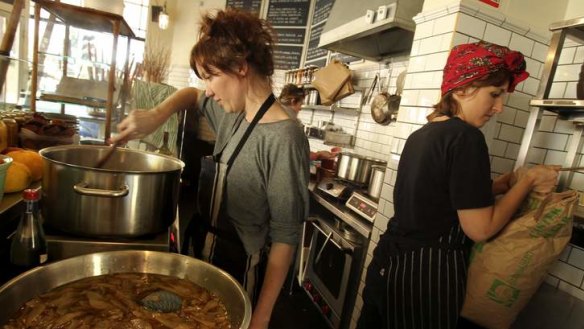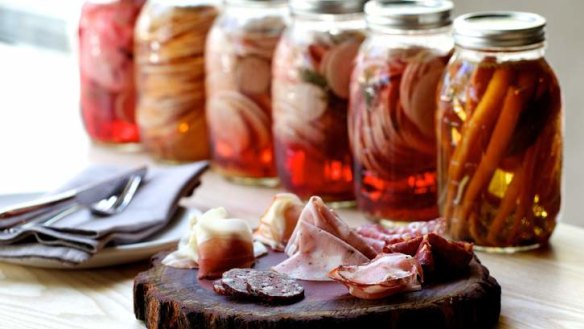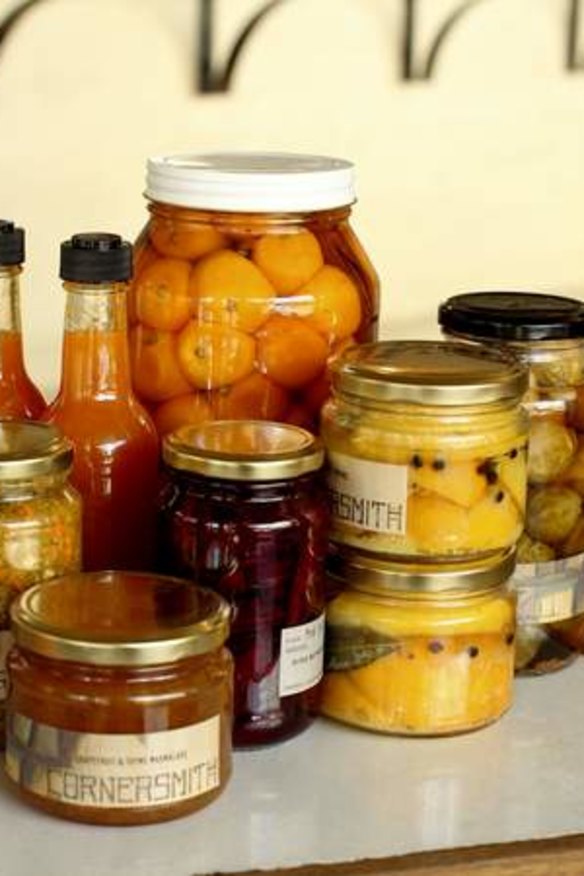Relishing the return of the preserve
A kitchen skill often linked with earlier generations is making a comeback.

What do you think of when you think of pickling? Your Depression-era granny who never let excess fruit go to waste? The jar of … something … that's been at the back of the fridge for a few years now? The mystery, almost phosphorescent, phallic things in the jar that were a present from Aunt Mavis that you're too scared to throw out but too terrified to eat? Forget all that. Pickling is back, baby - big time.
One Wednesday night recently in Rosebery, as a 12-piece Afro-funk band were tuning up, about a hundred people met at Kitchen by Mike to learn how to pickle.
If the crowd were ingredients to be pickled I'd say they were a base vegetable of 60 per cent young hipster, a brine of 20 per cent baby-boomer retirees who have been meaning to get around to doing something with the backyard lemon tree, and a sprinkled spice of 20 per cent very busy Sydney eastern suburbs professionals who see pickling as the first step in slowing down.

In the cavernous industrial space, the amateur picklers were put through a whirl of activities. There was a long trestle table with people dicing rhubarb into 1cm pieces to be tossed into sugar and made into ''Mike's Rhubarb Jam''. At another work station was the beetroot crew, making Grant's Beetroot Relish, while I loved learning how to make preserved lemons, although maybe old associations were at play as the abundance of lemon and salt reminded me of younger, more wild nights where tequila was involved.
I introduced myself to pickling students Kaz Thomas, Bondi, and Paulette Reardon, Edgecliff, as they enjoyed a break to eat charcuterie dinner and have a glass of wine. Both in their early 30s, they saw the pickling workshop as a fun night out but also a chance to learn some useful skills. Thomas grew up on a farm with a mother who made jams, ''but I want to be exposed to other kinds of pickling''.
Says Reardon, ''There is a trend to make stuff yourself. All our friends are pretty good cooks.''

If you are time poor and think life's too short to pickle a cucumber - think again. The art of pickling is not particularly complex.
The Cornersmith in Marrickville is teaching pickling to packed houses in their evening and Saturday classes.
The class is a diverse mix of early twenty-somethings, stay-at-home mums and retirees.
There are always a few men sprinkled throughout the class, but pickling is still predominantly the preserve of women, says Alex Elliot-Howery of the Cornersmith picklery.
Currently Elliot-Howery is teaching a spring preserving class. She starts each class explaining why she preserves. ''It's seasonal, small batch, an old food-craft, it saves wastage. We support local and seasonal growers. At the height of the season it's a really good way of using things that won't make it.''
In the preserving classes, students learn to make fruit chutney and spring pickles and are given basic recipes which they can interchange with different ingredients.
Pickles are versatile, says Elliot-Howery, ''They can be used in a cheese plate, antipasto, we put a lot through salads, we have them on a slaw, or in a cheese and pickle sandwich.''
Students are taught how best to sterilise the pickle jars and then shown how to make the brine where the pickles rest.
''Pickling is essentially preserving in brine,'' says Elliot-Howery.
For something that is essentially just placing a few things in a jar and storing it, some people come to the classes after having tried and failed at home. Common mistakes include failure to sterilise the jars and equipment, changing the ratios on ingredients and overcooking or undercooking ingredients.
''Sanitising is important as any bacteria will ruin the pickles,'' says Elliot-Howery.
I watch the three cooks in the Cornersmith picklery make a batch of zucchini, fennel and mustard-seed pickles.
The sliced raw vegetables which have been mixed with spices are placed in a sterilised jar and the brine is poured in hot to slightly cook/blanch the vegetables. ''Then it's still crunchy,'' says Elliot-Howery.
These pickles will be ready to eat in four to six weeks and will keep for six months.
Elliot-Howery started pickling when she and fellow pickler Jaimee Edwards were both stay-at-home mums.
''We went on a rampage and decided not to eat anything that wasn't Australian and wasn't from an ethical company - and we found there wasn't anything to eat any more. So we just got together once a week and went on food adventures and we'd make everything under the sun … The big attraction is that it's sustainable.''
The pair started selling their pickles at school fetes and ''then it went nuts''.
That was almost four years ago and now the picklery is going strong with classes also in bread making and home cheese making.
''Pickling is coming back because all craft and home-style is back in fashion - people want to understand where things come from. People are using it as a way to slow down. People don't want to buy gifts any more. They want to make stuff that people will really appreciate,'' says Elliot-Howery.
So when to start? Well, how about now. ''Summer is the best time for preserving, there's just so much of it [fruit] … stonefruit, tomatoes. It's a good time to make lots of jams, syrups and cordials.''
Cornersmith Pickling and Preserving classes, November 21, workshops@cornersmith.com.au
The best recipes from Australia's leading chefs straight to your inbox.
Sign up